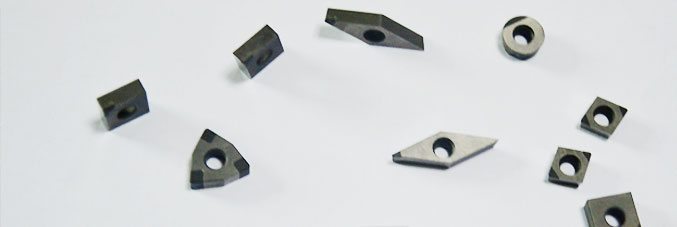
Cubic Boron Nitride tools were mainly used for precision machining. In recent decades, technological innovations have been carried out on the purity and grain size of raw materials. Using composite materials and hot-pressing techniques, the brittleness has been greatly improved, and the toughness has been improved. Greatly improved, it can be used as a conventional tool in production, and plays an important role in improving work efficiency and ensuring product quality.
Cubic boron nitride tool material performance characteristics:
The cubic boron nitride tool refers to a tool that uses cubic boron nitride (CBN) as a cutting part. Cubic Boron Nitride (CBN) is one of the isomers of boron nitride BN. Its structure is similar to that of diamond, and it is a superhard material artificially synthesized by ultrahigh temperature and high pressure technology. Its hardness is second only to diamond (microhardness up to 8000-9000 HV), and its thermal stability is high (up to 1250~1350°C). It is chemically inert to iron group elements and has strong anti-adhesion ability. It can be ground with diamond grinding wheel. Sharp edge, it is suitable for processing more than 35HRC hard materials, such as various hardened steel (carbon tool steel, alloy tool steel, high speed steel, bearing steel, die steel, etc.), chilled cast iron, cobalt base and nickel base High-hard alloys, hard alloys, surface coating (welding) materials and other hard and wear-resistant materials, can also be used for the processing of titanium alloys, pure nickel, pure tungsten and other materials. It is one of the best tools for grinding and grinding instead of grinding. The surface roughness of hardened steels processed with cubic boron nitride tools is Ra1.60.4μm, with an accuracy of IT7IT6.
Cubic boron nitride tools also have limitations in use, such as their greater brittleness, poor strength and toughness, and are not suitable for intermittent surface machining under impact loads. In addition, when using it to process soft iron element materials, it is easy to produce long chips, which will scratch the rake face of the tool and form a built-up edge. This will cause the cutting force to fluctuate and damage the tool.
In order to improve the impact resistance of CBN tools, we have now developed a novel WBN material (WBN) synthesized from explosives using graphite-like hexagonal boron nitride (g-BN or h-BN) as raw material. Is a lead-zinc ore structure of BN). It has high toughness and sintering activity, is easily converted to CBN, and is easily co-fired with CBN to a polycrystalline body with strength and hardness close to that of CBN.
The two-phase sintered body of WBN and CBN is made up of the toughness of WBN to make up for the brittleness of CBN. Its impact strength is 60% higher than that of pure CBN sintered body, the fracture toughness is increased by 2.53 times, and the flexural strength is increased by about 1 time. The compressive strength is comparable to that of cemented carbide, and the thermal stability is 1100 to 1200°C. Workpieces that can be used to machine intermittent surfaces, such as gear tooth surfaces, surfacing surfaces, or grooved workpieces.
Currently, WBN and CBN's two-phase sintered body tools have been widely used in the automotive industry in the United States, Japan, and Russia, such as for connecting rods, tappets, cylinder liners, brake-brake wheels, crankshafts, and flywheels. A variety of pump shell parts in the car, boring and milling processes.
